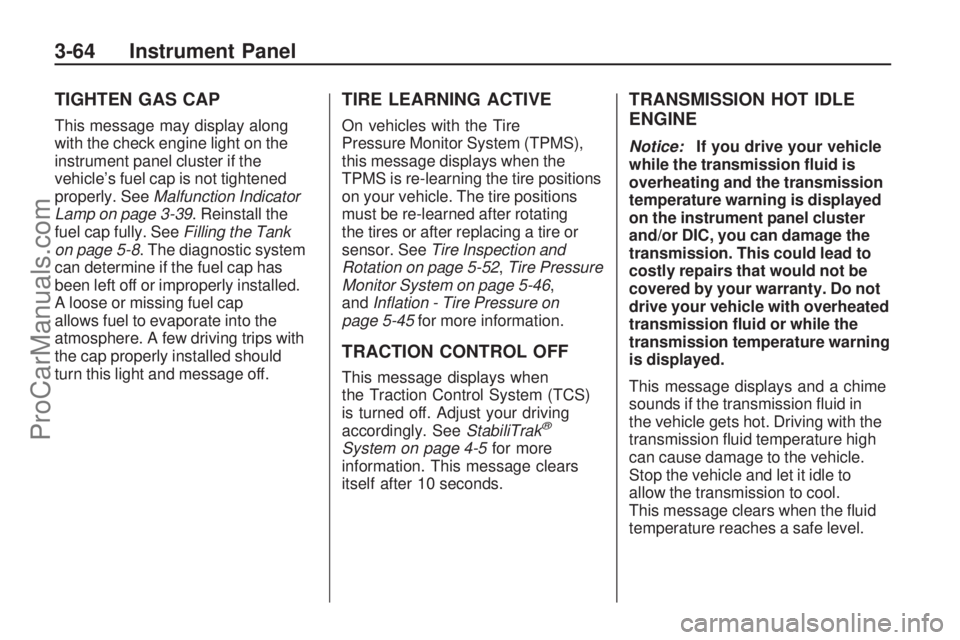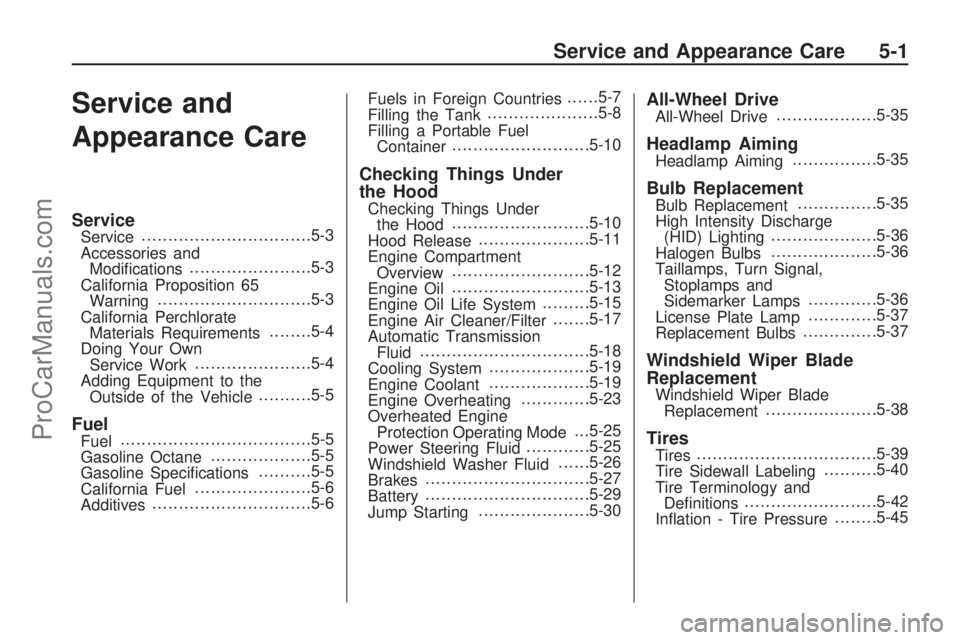check engine light SATURN OUTLOOK 2009 User Guide
[x] Cancel search | Manufacturer: SATURN, Model Year: 2009, Model line: OUTLOOK, Model: SATURN OUTLOOK 2009Pages: 432, PDF Size: 2.48 MB
Page 186 of 432

TIGHTEN GAS CAP
This message may display along
with the check engine light on the
instrument panel cluster if the
vehicle’s fuel cap is not tightened
properly. SeeMalfunction Indicator
Lamp on page 3-39. Reinstall the
fuel cap fully. SeeFilling the Tank
on page 5-8. The diagnostic system
can determine if the fuel cap has
been left off or improperly installed.
A loose or missing fuel cap
allows fuel to evaporate into the
atmosphere. A few driving trips with
the cap properly installed should
turn this light and message off.
TIRE LEARNING ACTIVE
On vehicles with the Tire
Pressure Monitor System (TPMS),
this message displays when the
TPMS is re-learning the tire positions
on your vehicle. The tire positions
must be re-learned after rotating
the tires or after replacing a tire or
sensor. SeeTire Inspection and
Rotation on page 5-52,Tire Pressure
Monitor System on page 5-46,
andInflation - Tire Pressure on
page 5-45for more information.
TRACTION CONTROL OFF
This message displays when
the Traction Control System (TCS)
is turned off. Adjust your driving
accordingly. SeeStabiliTrak
®
System on page 4-5for more
information. This message clears
itself after 10 seconds.
TRANSMISSION HOT IDLE
ENGINE
Notice:If you drive your vehicle
while the transmission �uid is
overheating and the transmission
temperature warning is displayed
on the instrument panel cluster
and/or DIC, you can damage the
transmission. This could lead to
costly repairs that would not be
covered by your warranty. Do not
drive your vehicle with overheated
transmission �uid or while the
transmission temperature warning
is displayed.
This message displays and a chime
sounds if the transmission �uid in
the vehicle gets hot. Driving with the
transmission �uid temperature high
can cause damage to the vehicle.
Stop the vehicle and let it idle to
allow the transmission to cool.
This message clears when the �uid
temperature reaches a safe level.
3-64 Instrument Panel
ProCarManuals.com
Page 254 of 432

And, of course, actual stopping
distances vary greatly with the
surface of the road, whether it is
pavement or gravel; the condition of
the road, whether it is wet, dry, or
icy; tire tread; the condition of
the brakes; the weight of the vehicle;
and the amount of brake force
applied.
Avoid needless heavy braking. Some
people drive in spurts — heavy
acceleration followed by heavy
braking — rather than keeping pace
with traffic. This is a mistake. The
brakes might not have time to cool
between hard stops. The brakes will
wear out much faster with a lot of
heavy braking. Keeping pace with
the traffic and allowing realistic
following distances eliminates a lot of
unnecessary braking. That means
better braking and longer brake life.
If the engine ever stops while the
vehicle is being driven, brake
normally but do not pump the
brakes. If the brakes are pumped,
the pedal could get harder to
push down. If the engine stops,there will still be some power brake
assist but it will be used when
the brake is applied. Once the power
assist is used up, it can take
longer to stop and the brake pedal
will be harder to push.
Adding non-dealer/non-retailer
accessories can affect vehicle
performance. SeeAccessories and
Modifications on page 5-3.
Antilock Brake
System (ABS)
This vehicle has the Antilock Brake
System (ABS), an advanced
electronic braking system that helps
prevent a braking skid.
When the engine is started and the
vehicle begins to drive away, ABS
checks itself. A momentary motor or
clicking noise might be heard while
this test is going on, and it might
even be noticed that the brake pedal
moves a little. This is normal.If there is a problem with ABS, this
warning light stays on. See
Antilock Brake System (ABS)
Warning Light on page 3-37.
Let us say the road is wet and you
are driving safely. Suddenly, an
animal jumps out in front of you. You
slam on the brakes and continue
braking. Here is what happens
with ABS:
A computer senses that the wheels
are slowing down. If one of the
wheels is about to stop rolling, the
computer will separately work
the brakes at each wheel.
ABS can change the brake pressure
to each wheel, as required, faster
than any driver could. This can help
the driver steer around the obstacle
while braking hard.
4-4 Driving Your Vehicle
ProCarManuals.com
Page 287 of 432

Service and
Appearance Care
ServiceService................................5-3
Accessories and
Modi�cations.......................5-3
California Proposition 65
Warning.............................5-3
California Perchlorate
Materials Requirements........5-4
Doing Your Own
Service Work......................5-4
Adding Equipment to the
Outside of the Vehicle..........5-5
FuelFuel....................................5-5
Gasoline Octane...................5-5
Gasoline Speci�cations..........5-5
California Fuel......................5-6
Additives..............................5-6Fuels in Foreign Countries......5-7
Filling the Tank.....................5-8
Filling a Portable Fuel
Container..........................5-10
Checking Things Under
the Hood
Checking Things Under
the Hood..........................5-10
Hood Release.....................5-11
Engine Compartment
Overview..........................5-12
Engine Oil..........................5-13
Engine Oil Life System.........5-15
Engine Air Cleaner/Filter.......5-17
Automatic Transmission
Fluid................................5-18
Cooling System...................5-19
Engine Coolant...................5-19
Engine Overheating.............5-23
Overheated Engine
Protection Operating Mode. . .5-25
Power Steering Fluid............5-25
Windshield Washer Fluid......5-26
Brakes...............................5-27
Battery...............................5-29
Jump Starting.....................5-30
All-Wheel DriveAll-Wheel Drive...................5-35
Headlamp AimingHeadlamp Aiming................5-35
Bulb ReplacementBulb Replacement...............5-35
High Intensity Discharge
(HID) Lighting....................5-36
Halogen Bulbs....................5-36
Taillamps, Turn Signal,
Stoplamps and
Sidemarker Lamps.............5-36
License Plate Lamp.............5-37
Replacement Bulbs..............5-37
Windshield Wiper Blade
Replacement
Windshield Wiper Blade
Replacement.....................5-38
TiresTires..................................5-39
Tire Sidewall Labeling..........5-40
Tire Terminology and
De�nitions.........................5-42
In�ation - Tire Pressure........5-45
Service and Appearance Care 5-1
ProCarManuals.com
Page 392 of 432

(d)Inspect wiper blades for wear,
cracking, or contamination. Clean
the windshield and wiper blades,
if contaminated. Replace wiper
blades that are worn or damaged.
See Windshield Wiper Blade
Replacement on page 5-38 and
Windshield, Backglass, and Wiper
Blades on page 5-88 for more
information.
(e)Make sure the safety belt
reminder light and safety belt
assemblies are working properly.
Look for any other loose or damaged
safety belt system parts. If you see
anything that might keep a safety belt
system from doing its job, have it
repaired. Have any torn or frayed
safety belts replaced. Also see
Checking the Restraint Systems
on page 1-61.(f)Lubricate all key lock cylinders,
hood latch assemblies, secondary
latches, pivots, spring anchor
and release pawl, hood and door
hinges, rear folding seats, and
liftgate hinges. More frequent
lubrication may be required when
exposed to a corrosive environment.
Applying silicone grease on
weatherstrips with a clean cloth will
make them last longer, seal
better, and not stick or squeak.
(g)A fluid loss in any vehicle
system could indicate a problem.
Have the system inspected
and repaired and the fluid level
checked. Add fluid if needed.(h)Change automatic transmission
fluid if the vehicle is mainly driven
under one or more of these
conditions:
�In heavy city traffic where the
outside temperature regularly
reaches 90°F (32°C) or higher.
�In hilly or mountainous terrain.
�When doing frequent trailer
towing.
�Uses such as found in taxi, police,
or delivery service.
(i)Drain, flush, and refill cooling
system. This service can be
complex; you should have your
dealer/retailer perform this service.
See Engine Coolant on page 5-19 for
what to use. Inspect hoses. Clean
radiator, condenser, pressure cap,
and filler neck. Pressure test the
cooling system and pressure cap.
6-8 Maintenance Schedule
ProCarManuals.com
Page 422 of 432

B
Battery...............................5-29
Electric Power
Management.................3-15
Run-Down Protection.........3-16
Belt Routing, Engine.............6-15
Bluetooth
®.........................3-103
Brake
Emergencies...................... 4-5
Brake Fluid.........................5-27
Brakes...............................5-27
Antilock............................. 4-4
Parking...........................2-27
System Warning Light.......3-36
Braking................................ 4-3
Braking in Emergencies.......... 4-5
Break-In, New Vehicle..........2-20
Bulb Replacement................5-37
Fog Lamp ........................3-13
Halogen Bulbs..................5-36
Headlamp Aiming..............5-35
Headlamps......................5-35
High Intensity Discharge
(HID) Lighting...............5-36Bulb Replacement (cont.)
License Plate Lamps.........5-37
Taillamps, Turn Signal,
Stoplamps and
Sidemarker Lamps.........5-36
Buying New Tires.................5-54
C
Calibration..........................3-54
California
Perchlorate Materials
Requirements................. 5-4
California Fuel....................... 5-6
California Proposition 65
Warning............................ 5-3
Camera, Rear Vision............2-37
Canadian Owners..................... ii
Capacities and
Speci�cations...................5-98
Carbon Monoxide.................2-11
Engine Exhaust................2-30
Liftgate............................2-10
Winter Driving..................4-15
Care of
Safety Belts.....................5-86Cargo
Tie Downs .......................2-53
Cargo Cover........................2-53
Cargo Management System....2-53
CD, MP3 ....................3-92, 3-97
Center Console Storage........2-50
Chains, Tire........................5-60
Charging System Light..........3-35
Check
Engine Lamp...................3-39
Checking Things Under
the Hood .........................5-10
Chemical Paint Spotting........5-90
Child Restraints
Infants and Young
Children.......................1-30
Lower Anchors and
Tethers for Children.......1-37
Older Children..................1-28
Securing a Child Restraint
in a Rear Seat Position....1-43
Securing a Child Restraint
in the Right Front Seat
Position.......................1-45
Systems..........................1-33
Where to Put the
Restraint......................1-35
i-2 INDEX
ProCarManuals.com
Page 424 of 432

Driver
Seat Height Adjuster........... 1-3
Driver Information
Center (DIC)....................3-44
DIC Operation and
Displays...............3-45, 3-50
DIC Vehicle
Customization...............3-65
DIC Warnings and
Messages....................3-56
Driving
At Night..........................4-11
Before a Long Trip............4-13
Defensive.......................... 4-2
Drunk............................... 4-2
Highway Hypnosis............4-13
Hill and Mountain Roads.....4-14
In Rain and on
Wet Roads...................4-12
Loss of Control................4-10
Off-Road Recovery............. 4-9
Rocking Your Vehicle to
Get it Out ....................4-18
Winter.............................4-15
Driving for Better Fuel
Economy........................... 4-1Dual Automatic Climate
Control System.................3-22
DVD
Rear Seat Entertainment
System......................3-114
E
EDR ..................................7-16
Electrical Equipment
Add-On Equipment............5-92
Electrical System
Fuses and Circuit
Breakers......................5-92
Instrument Panel Fuse
Block...........................5-92
Power Windows and Other
Power Options..............5-92
Underhood Fuse Block......5-94
Windshield Wiper Fuses....5-92
Electronic Immobilizer
PASS-Key
®III+................2-18
Electronic Immobilizer
Operation
PASS-Key
®III+................2-18Engine
Air Cleaner/Filter...............5-17
Check and Service Engine
Soon Lamp..................3-39
Compartment Overview......5-12
Coolant...........................5-19
Coolant Heater.................2-23
Coolant
Temperature Gage.........3-38
Coolant Temperature
Warning Light...............3-38
Cooling System................5-19
Drive Belt Routing.............6-15
Exhaust...........................2-30
Oil ..................................5-13
Oil Life System.................5-15
Overheated Protection
Operating Mode............5-25
Overheating.....................5-23
Starting...........................2-22
Entry Lighting......................3-14
Event Data Recorders..........7-17
Extender, Safety Belt............1-28
Exterior Lamps....................3-11
i-4 INDEX
ProCarManuals.com
Page 426 of 432

High Voltage Devices and
Wiring.............................5-91
Highbeam On Light..............3-43
Highway Hypnosis................4-13
Hill and Mountain Roads.......4-14
Hood
Checking Things Under.....5-10
Release..........................5-11
Horn .................................... 3-5
How to Wear Safety Belts
Properly..........................1-18
I
Ignition Positions..................2-20
Infants and Young Children,
Restraints........................1-30
In�ation - Tire Pressure.........5-45
Instrument Panel
Brightness.......................3-13
Cluster............................3-31
Overview........................... 3-4
Storage Area....................2-50
Introduction........................... 6-1
J
Jump Starting......................5-30
K
Keyless Entry, Remote
Operation.......................... 2-4
Keyless Entry System............ 2-3
Keys.................................... 2-2
L
Labeling, Tire Sidewall..........5-40
Lamp
Malfunction Indicator.........3-39
Lamps
Courtesy.........................3-13
Dome .............................3-14
Dome Lamp Override........3-14
License Plate...................5-37
Reading..........................3-15
Lap-Shoulder Belt................1-23
LATCH System for
Child Restraints................1-37
Liftgate
Carbon Monoxide.............2-10
Liftgate, Power....................2-11
Lighting
Delayed Entry..................3-14
Delayed Exit....................3-15
Entry..............................3-14
Parade Dimming...............3-15Lights
Airbag Readiness.............3-33
Antilock Brake System
(ABS) Warning..............3-37
Brake System Warning......3-36
Charging System..............3-35
Cruise Control..................3-43
Engine Coolant
Temperature Warning.....3-38
Exterior Lamps.................3-11
Flash-to-Pass..................... 3-7
Fog Lamp ........................3-43
Highbeam On...................3-43
High/Low Beam Changer..... 3-7
Oil Pressure.....................3-42
Passenger Airbag Status
Indicator.......................3-34
Safety Belt Reminders.......3-32
Security...........................3-43
StabiliTrak
®Indicator.........3-37
Tire Pressure...................3-39
Tow/Haul Mode................3-43
Loading Your Vehicle............4-18
Locks
Delayed Locking................. 2-8
Door ................................. 2-8
Lockout Protection.............. 2-9
i-6 INDEX
ProCarManuals.com
Page 427 of 432

Locks (cont.)
Power Door ....................... 2-8
Programmable Automatic
Door Locks.................... 2-9
Rear Door Security Locks..... 2-9
Loss of Control....................4-10
Lower Anchors and
Tethers for Children...........1-37
Luggage Carrier...................2-52
Lumbar
Manual Controls................. 1-4
Power Controls.................. 1-5
M
Maintenance
Footnotes.......................... 6-7
Maintenance Schedule
Additional Required
Services........................ 6-6
At Each Fuel Fill................ 6-9
At Least Once a Month.....6-10
At Least Once a Year.......6-10
Maintenance Record.........6-16
Maintenance
Replacement Parts.........6-14
Maintenance Requirements . . . 6-1Maintenance Schedule (cont.)
Owner Checks and
Services........................ 6-9
Recommended Fluids and
Lubricants....................6-12
Scheduled Maintenance....... 6-3
Using............................... 6-2
Your Vehicle and the
Environment................... 6-1
Malfunction Indicator Lamp....3-39
Manual Lumbar Controls......... 1-4
Manual Seats........................ 1-3
Memory Seat and Mirrors....... 1-6
Message
DIC Warnings and
Messages....................3-56
Mirrors
Automatic Dimming
Rearview......................2-31
Manual Rearview Mirror.....2-31
Outside Convex Mirror.......2-34
Outside Heated Mirrors......2-34
Outside Power Foldaway
Mirrors.........................2-33
Outside Power Mirrors.......2-32
Park Tilt..........................2-34
MP3 ...........................3-92, 3-97
N
Navigation System, Privacy....7-18
Navigation/Radio System,
see Navigation Manual.....3-103
Net
Convenience....................2-52
New Vehicle Break-In...........2-20
O
Odometer...........................3-32
Off-Road
Recovery.......................... 4-9
Oil
Engine............................5-13
Engine Oil Life System......5-15
Pressure Light..................3-42
Older Children, Restraints......1-28
Online Owner Center.............. 7-4
OnStar, Privacy....................7-18
OnStar
®System, see
OnStar®Manual...............2-42
Operation, Universal Home
Remote System................2-46
Outlet Adjustment.................3-27
Outlets
Accessory Power..............3-17
INDEX i-7
ProCarManuals.com